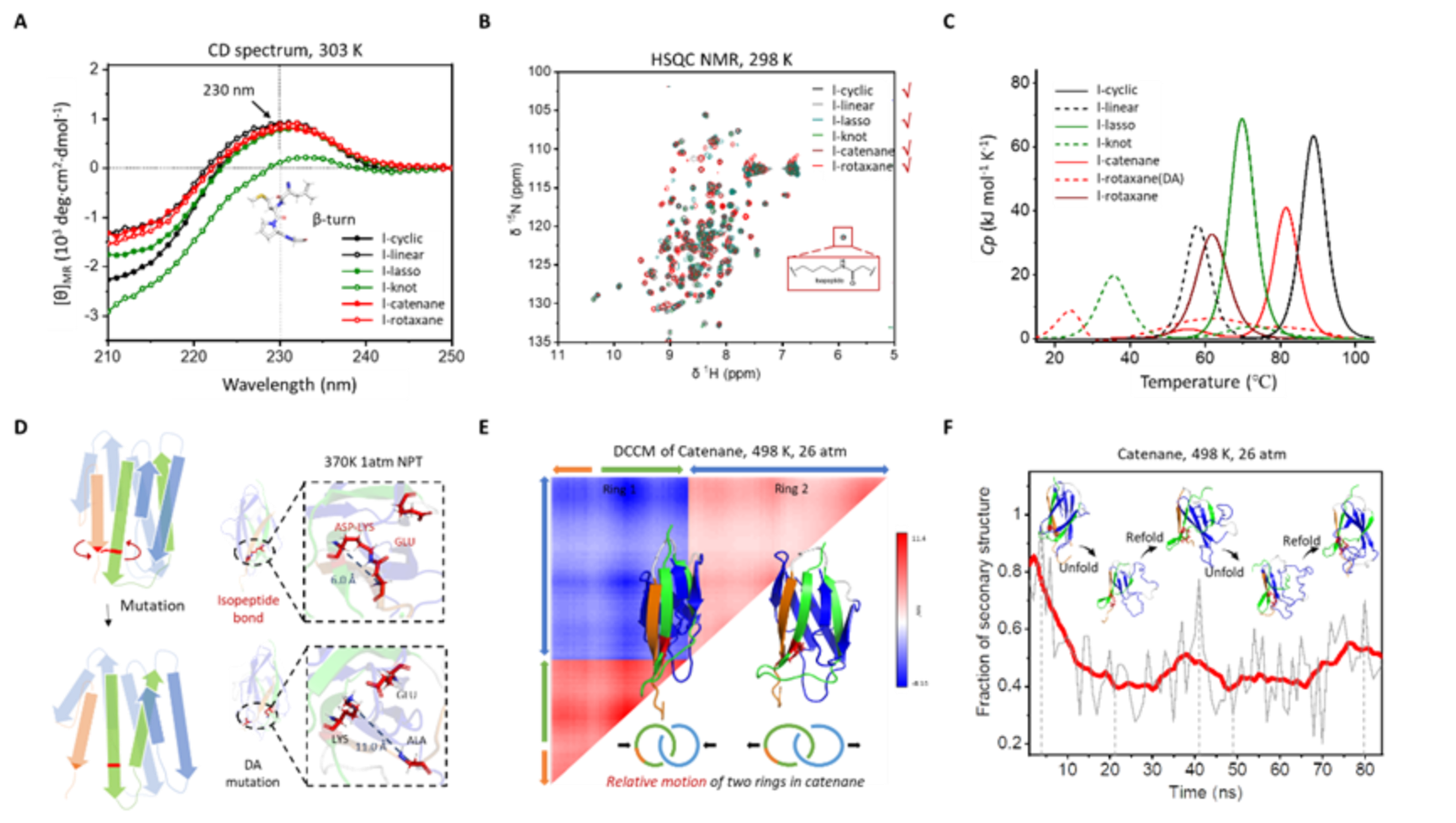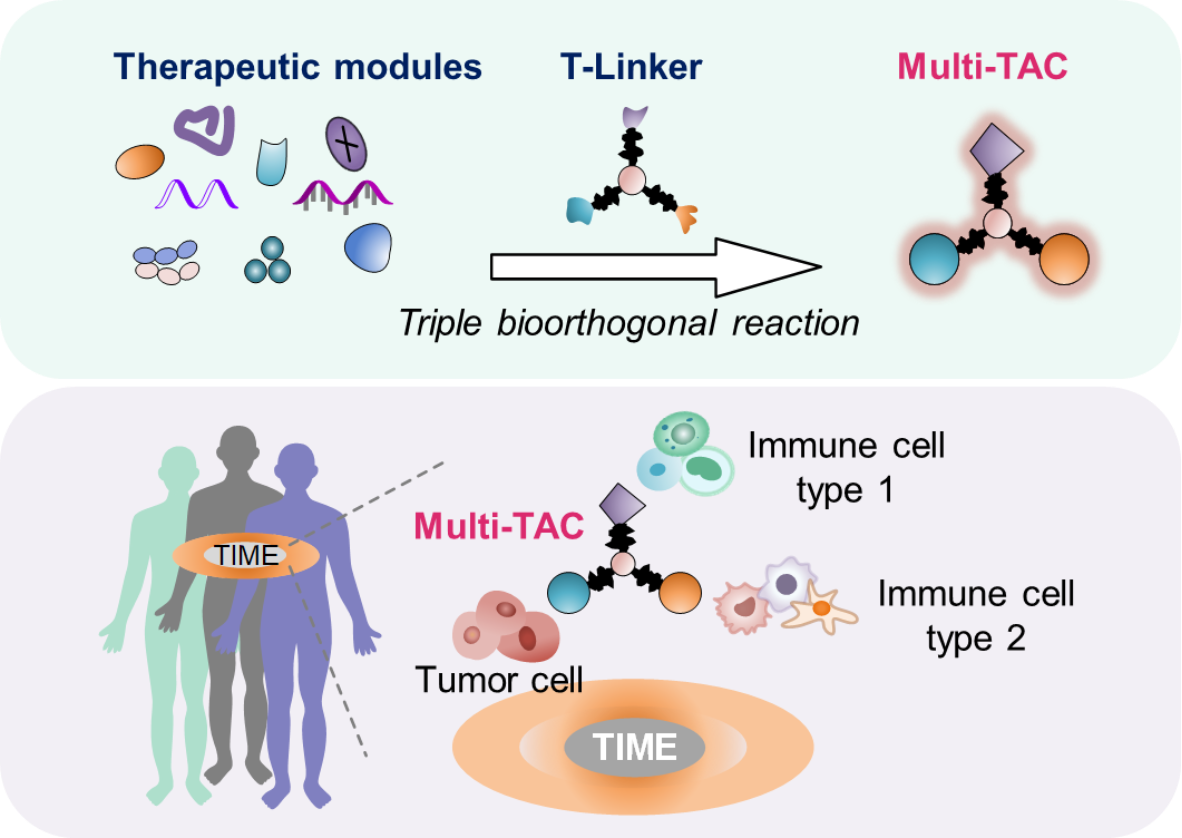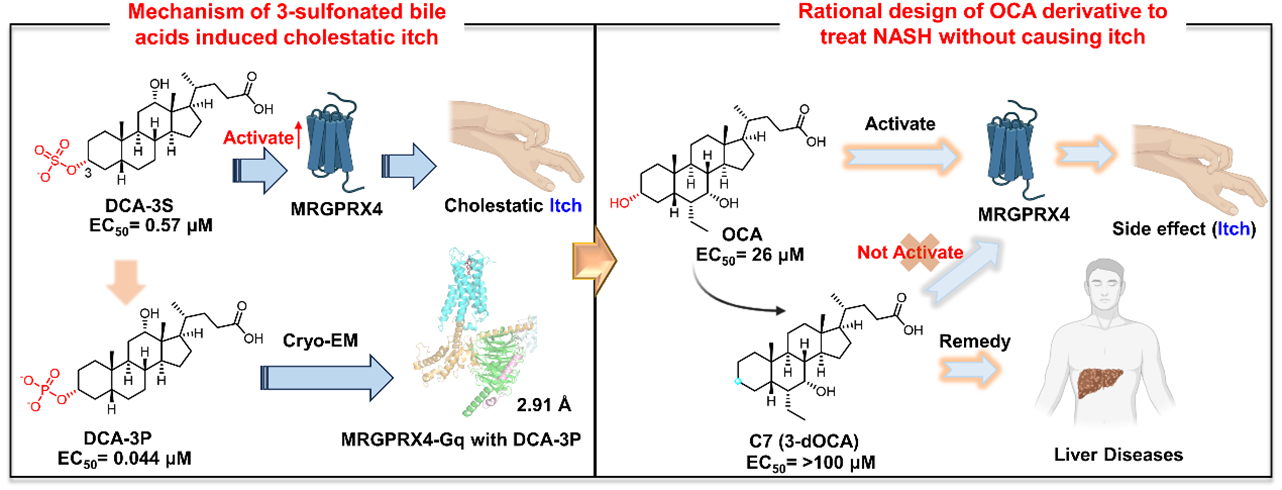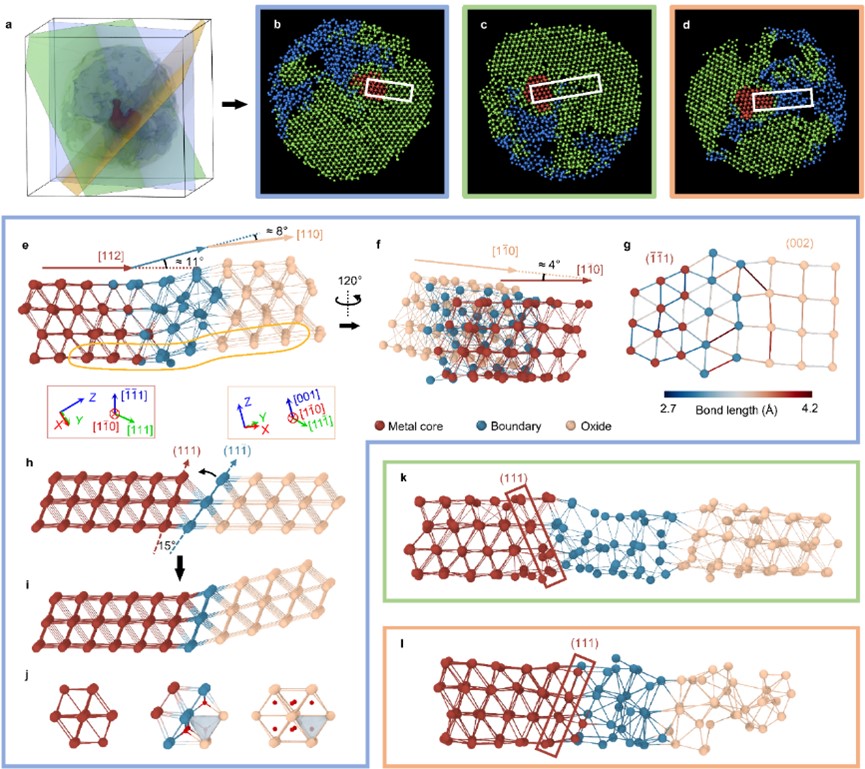伊人直播
On July 22, 2024, a joint research team led by Professor Hailin Peng from the College of Chemistry and Molecular Engineering at Peking University published an article entitled "Even-integer quantum Hall effect in an oxide caused by a hidden Rashba effect" in Nature Nanotechnology. The study reported the novel hidden-spin-polarization-induced even-integer quantum Hall effect (QHE) in the bismuth-based 2D semiconductor Bi2O2Se.
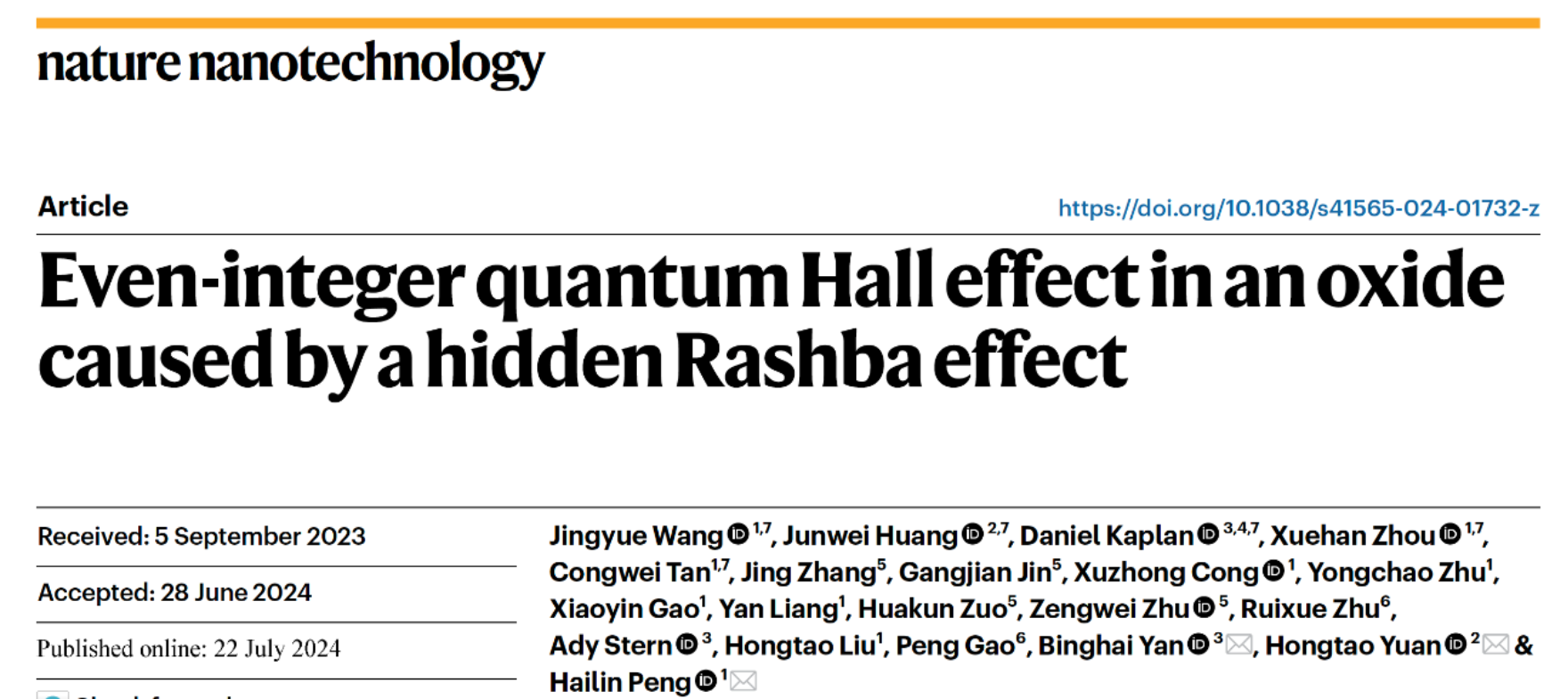
Video: The discovery of the even-integer quantum Hall effect in Bi2O2Se
The QHE is one of the most significant scientific breakthroughs in condensed matter physics since the 20th century.The energy of electrons will split into Landau levels under high magnetic field in two-dimensional (2D) systems. At this time, the Hall resistance no longer satisfies the linear relationship and will be quantized into plateaus of h/νe2, where ν is the filling factor.The integer and fractional QHE were discovered experimentally in 1980 and 1982, respectively, which initiated the study of topological states. Due to the non-dissipative topological boundary states, the longitudinal resistance should be zero, which is expected to build non-dissipative or low-power electronic devices to overcome the heating and energy dissipation problems of chips.
However, the experimental observation of QHE poses significant challenges due to thestringent requirement of high-mobility 2D electron systems and the complexity of experimental measurement processes.In recent years, the development of 2D semiconductors has provided new opportunities to explore the QHE and novel quantum states.In these 2D semiconductors, the degrees of freedom of charge, orbit and spin can be manipulated at the atomic level to achieve precise control of symmetry, polar field, spin-orbit coupling (SOC), band structure and spin texture. Up to now, scientists have observed integer QHE in a variety of 2D semiconducting systems such as black phosphorus, indium selenide, etc. However, in these previously-reported QHE in 2D materials, the quantization in a high magnetic field is mainly dominated by the Zeeman effect and the SOC is relatively small due to the light atomic weight therein, resulting in the coexistence of both odd- and even-integer quantum Hall plateaus. Thus, it is difficult to achieve experimental breakthrough in the regulation of quantum Hall states.
In response to the above issues, Professor Hailin Peng’s research team from the College of Chemistry and Molecular Engineering at Peking University, in collaboration with Professor Hongtao Yuan's team from Nanjing University and Professor Binghai Yan's team from the Weizmann Instituteof Science in Israel, proposed a strategy to achieve the selective control of odd- and even-integer quantum Hall states through symmetry engineering in a 2D semiconducting system with strong SOC.In high-mobility 2D bismuth-based semiconductor, Bi2O2Se, the novel even-integer QHE induced by hidden spin polarizations was discovered for the first time, and the selective control of odd- and even-integer quantum Hall states was realized.

Fig. 1 The schematic view of the hidden-Rashba-effect-induced even-integer QHE in Bi2O2Se.
In recent years, Professor Hailin Peng's research group at Peking University has developed an ultra-high-mobility two-dimensional bismuth-based semiconductor Bi2O2Se and its high k dielectric Bi2SeO5. With the help of the unique properties of Bi2O2Se and Bi2SeO5, transistors with high speed and low power consumption, infrared detectors with ultra-fast response time and high sensitivity as well as high-performance gas sensors have been successfully fabricated (Nature Nanotech. 2017, 12, 530; Nature Commun. 2018, 9, 3311; Nature Electron. 2020, 3, 473; Nature Electron. 2022, 5, 643; Nature Mater. 2023, 22, 832; Nature 2023, 616, 66). In 2D Bi2O2Se, the electron states near the conduction band minimum originate from the heavy Bi p-orbital bands with strong SOC. Thus, it can serve as an ideal platform for exploring new QHE.When Professor Hailin Peng's research group first discovered and synthesized 2D semiconducting Bi2O2Se in June 20, 2015, the preliminary experimental exploration of QHE has started since then.However, the realization of QHE is highly demanding on the quality of materials and experimental conditions, which is hard to achieve. After years of unremitting efforts, the research group took the lead in establishing the chemical vapor deposition (CVD) method and molecular beam epitaxy (MBE) growth method of 2D Bi2O2Se single crystals in the world, realizing the precise control of the sample growth process at the atomic level, and the quality of 2D single crystal reached the international leading level.
Recently, the research team experimentally demonstrated the only even-integer quantum Hall states (filling factor ν = 2, 4, 6, 8...) in high-mobility layered Bi2O2Se under a pulsed magnetic field up to 50 T, while the odd-integer quantum Hall states (ν = 1, 3, 5, 7...) are missing. By means of experimental results and theoretical calculations, the unique even-integer QHE in Bi2O2Se can be attributed to the hidden Rashba effect.The conducting channels of Bi2O2Se mainly locate at [Bi2O2]2+ layers. Forthe [Bi2O2]2+ layer consisting of one O layer sandwiched by two Bi monolayers with the dipole and strong atomic SOC, each Bi monolayer feels a strong Rashba effect while neighboring Bi monolayers exhibit opposite signs of Rashba SOC. Thus, each [Bi2O2]2+ layer forms a Rashba bilayer structure (Fig. 1), in which the energy bands are spin-degenerated and the total Rashba effect is hidden (hidden Rashba effect). Theoretical calculations revealed that the special hidden Rashba effect will dramatically reduce the Zeeman splitting in Bi2O2Se under high magnetic field. As the conducting channels always appear in pair in [Bi2O2]2+ layers, the QHE in symmetric Bi2O2Se will only exhibit even-integer states (Fig. 2). Under high magnetic field up to 50 T, there only exists even-integer quantum Hall states in a 6-unit-cell (uc)-thick MBE-grown sample. Meanwhile, the only even-integer quantum Hall states in Bi2O2Se nanoflake also clearly emerged down to the quantum limit with filling factor ν = 2 under the magnetic field of 9 T (Fig. 2).
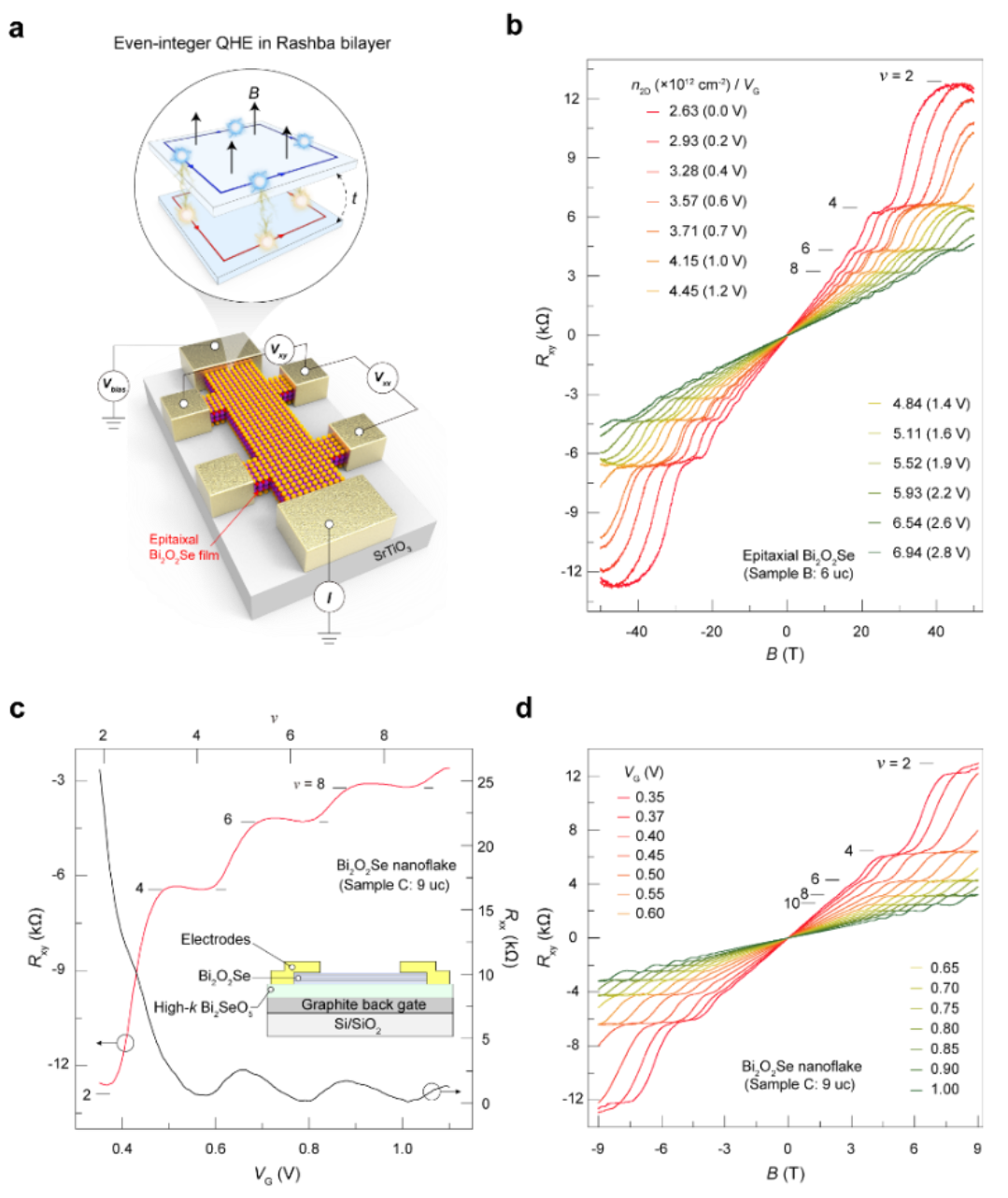
Fig. 2(a) Schematic views of the Hall bar device and even-integer QHE in Bi2O2Se film. (b) Hall resistance as a function of the magnetic field measured at varying electron densities in the 6-uc-thick Bi2O2Se film on SrTiO3 substrate. Only even-integer quantum Hall states can be observed in this sample. (c, d) Even-integer QHE in Bi2O2Se nanoflake grown by CVD method.
The researchers found thatthe quantum Hall states in layered 2D Bi2O2Se can be selectively controlled when tuning the out-of-plane polar field.The high-mobility Bi2O2Se films can be controllably grown by the MBE technique with different thicknesses on SrTiO3 substrates. As shown in Fig. 3, the interfacial Bi2O2Se layersare inversion-asymmetric and form Janus structures due to the absence of bottom Se atoms at the interface (Fig. 3a-c), resulting in a large polar field therein.In epitaxial Bi2O2Se films, the wave functions of electrons mainly locate at the middle region of the film. Thus, the transport behaviors of electrons are much less affected by the interfacial polar field in thick films (≥ 2.5 uc) than in ultra-thin films (1 uc). As the film thickness decreases to 1uc, the wavefunction of electrons reaches the interface and feels the interfacial polar field. So ultra-thin (e.g. 1 uc) films with asymmetric Janus structures exhibit strong global Rashba effect (Fig. 3f). At this condition, the Rashba bilayer scenario and hidden Rashba effect break down. Theoretical calculations reveal that the Zeeman splitting in Bi2O2Se will no longer be suppressed when the hidden Rashba effect vanishes, resulting in the appearance of both odd- and even- quantizedstates in the quantum Hall regime. (Fig. 3j)
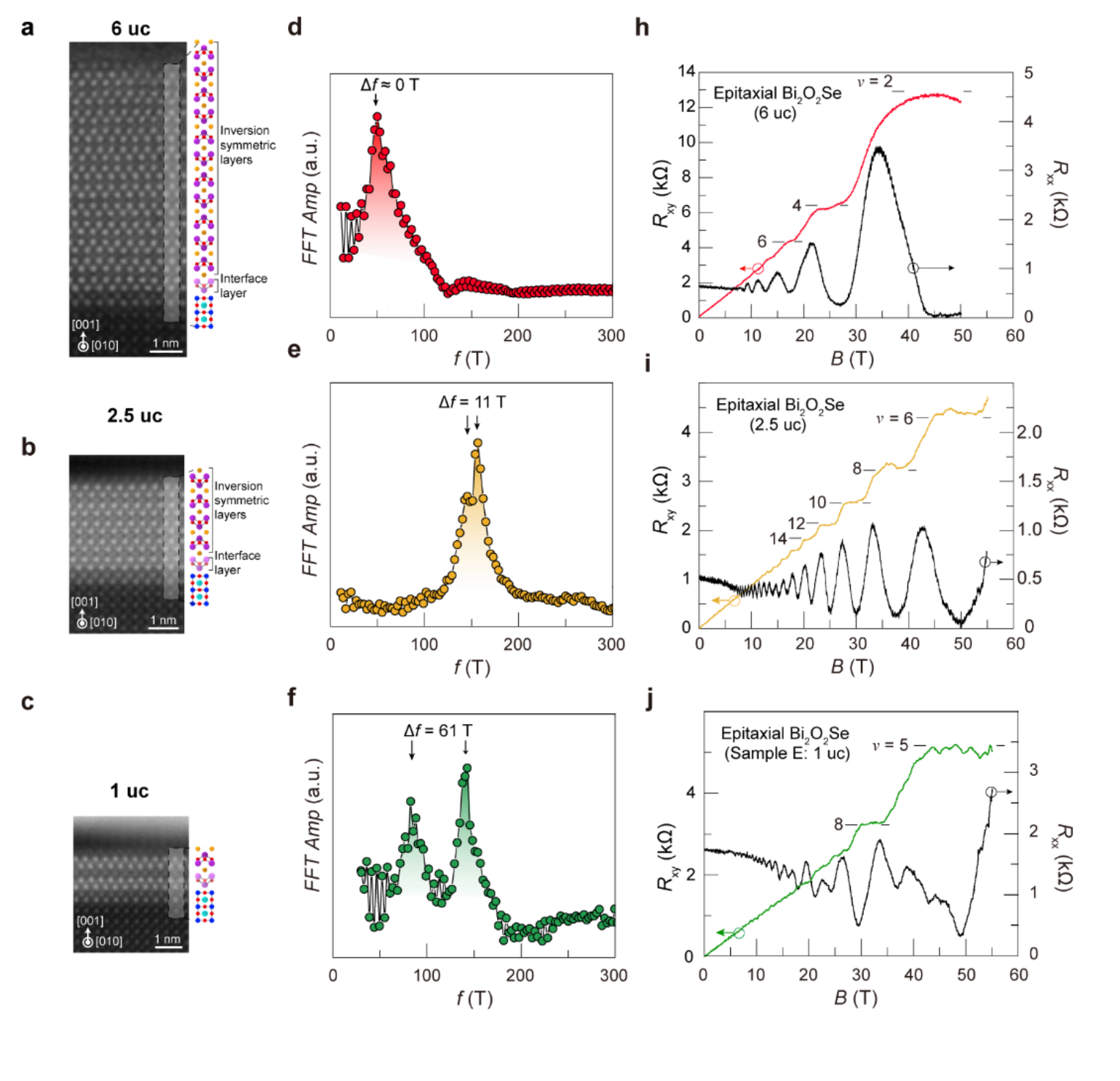
Fig. 3 (a-c) Cross-sectional HAADF-STEM images and crystal structures of Bi2O2Se films with different thicknesses that are epitaxially grown on SrTiO3. The films show asymmetric Janus structures due to the absence of Se atoms at interface. (d-f) The global Rashba splitting in epitaxial Bi2O2Se films.(h-j) QHE in epitaxial Bi2O2Se films with different thicknesses. In the1-uc-thick epitaxial film with Janus structure, both odd- and even-integer quantum Hall states can be observed.
In conclusion, the researchers have demonstrated the unique even-integer QHE in Bi2O2Se for the first time. The quantum Hall states in layered 2D Bi2O2Se can be selectively controlled via SOC engineering at atomic level. The results show that Bi2O2Se, a two-dimensional semiconductor with strong spin-orbit coupling effect and ultra-high mobility, is an ideal material platform for discovering novel QHE, regulating band topology and spin texture, exploring spin-related physical phenomena, and developing high-speed and low-power spintronic devices.
The work was published as an article entitled "Even-integer quantum Hall effect in an oxide caused by a hidden Rashba effect" in Nature Nanotechnology. Professor Hailin Peng from Peking University, Professor Hongtao Yuan from Nanjing University and Professor Binghai Yan from the Weizmann Instituteof Science in Israel are co-corresponding authors of the work. Dr. Jingyue Wang from Peking University, Dr. Junwei Huang from Nanjing University, Dr. Daniel Kaplan from Weizmann Instituteof Science in Israel, Dr. Xuehan Zhou and Dr. Congwei Tan from Peking University are co-first authors.The pulsed magnetic field experiments involved in this work were carried out in the Wuhan National High Magnetic Field Center in Huazhong University of Science and Technology, with the support from Professor Zengwei Zhu and Engineer Huakun Zuo.The work is also supported by Professor Peng Gao from Peking University and Professor Ady Stern from the Weizmann Instituteof Science in Israel.
This work was supported by the National Natural Science Foundation of China, the Ministry of Science and Technology of the People’s Republic of China, the Beijing National Laboratory for Molecular Sciences, the Tencent Foundation, the Boya PostdoctoralFellowship from Peking University, the European Research Council, and the Israel Science Foundation. The authors acknowledge Molecular Materials and Nanofabrication Laboratory (MMNL) in the College of Chemistry at Peking University for the support.
Link to the original article: //www.nature.com/articles/s41565-024-01732-z

